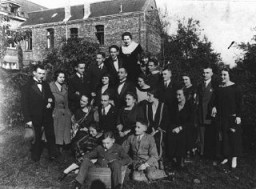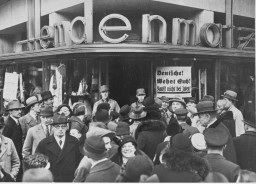![<p>Chart with the title "Die Nürnberger Gesetze" [<a href="/narrative/11475">Nuremberg Race Laws</a>]. In the fall of 1935, German Jews lost their citizenship according to the definitions posed in these new regulations. Only "full" Germans were entitled to the full protection of the law. This chart was used to aid Germans in understanding the laws. White circles represent "<a href="/narrative/63055">Aryan</a>" Germans, black circles represent Jews, and partially shaded circles represent “mixed raced” individuals. The chart has columns explaining the "Deutschbluetiger" [German-bloods], "Mischling 2. Grades" [Half-breeds 2. Grade], "Mischling 1. Grades" [Half-breeds 1. Grade], and "Jude" [<a href="/narrative/4967">Jew</a>].</p>
<p>What government officials, lawyers, and other professionals were involved in the development, distribution, and implementation of these measures?</p>](https://encyclopedia.ushmm.org/images/large/423ec6b8-6e77-4854-8f87-41610aa4c747.jpg)
The Nuremberg Race Laws
What were the Nuremberg Race Laws?
On September 15, 1935, the Nazi regime announced two new laws related to race:
- The Reich Citizenship Law
- The Law for the Protection of German Blood and German Honor
These laws informally became known as the Nuremberg Laws or Nuremberg Race Laws. This is because they were first announced at a Nazi Party rally held in the German city of Nuremberg.
Why did the Nazis enact the Nuremberg Race Laws?
The Nuremberg Race LawsThe Nazis enacted the Nuremberg Laws, because they wanted to put their ideas about race into law. They believed in the false theory that the world is divided into distinct races that are not equally strong and valuable. The Nazis considered Germans to be members of the supposedly superior “Aryan” race. They saw the so-called Aryan German race as the strongest, and most valuable race of all.
According to the Nazis, Jews were not Aryans. They thought Jews belonged to a separate race that was inferior to all other races. The Nazis believed that the presence of Jews in Germany threatened the German people. They believed they had to separate Jews from other Germans to protect and strengthen Germany. The Nuremberg Laws were an important step towards achieving this goal.
What was the Reich Citizenship Law?
The Nazi Party had always promised that, if they came to power, only racially pure Germans would be allowed to hold German citizenship. The Reich Citizenship Law made this a reality. This law defined a citizen as a person who is “of German or related blood.” This meant that Jews, defined as a separate race, could not be full citizens of Germany. They had no political rights.
What was the Law for the Protection of German Blood and German Honor?
The Law for the Protection of German Blood and German Honor was a law against what the Nazis viewed as race-mixing or “race defilement” (“Rassenschande”). It banned future intermarriages and sexual relations between Jews and people “of German or related blood.” The Nazis believed that such relationships were dangerous because they led to “mixed race” children. According to the Nazis, these children and their descendants undermined the purity of the German race.
Who was Jewish according to the Nuremberg Laws?
According to the Nuremberg Laws, a person with three or four Jewish grandparents was a Jew. A grandparent was considered Jewish if they belonged to the Jewish religious community. Thus, the Nazis defined Jews by their religion (Judaism), and not by the supposed racial traits that Nazism attributed to Jews.
The laws also categorized some people in Germany as “Mischlinge” (“mixed-race persons”). According to law, Mischlinge were neither German nor Jewish. These were people who had one or two Jewish grandparents.
The Nazi regime required individuals to prove their grandparents’ racial identities. To do so, people used religious records. These included baptism records, Jewish community records, and gravestones.
Did the Nuremberg Laws apply to other groups?
Yes. While initially focused on Jews, the Nazi government clarified that the Nuremberg Laws also applied to Roma (also called Gypsies), Black people, and their descendants. They could not be full citizens of Germany. Nor could they marry or have sexual relations with “people of German or related blood.”
What were the consequences of the Nuremberg Laws?
The Nuremberg Laws changed the everyday lives of Jews in Germany by making Jews legally different from their non-Jewish neighbors. In the years that followed, the Nazi regime enacted more and more anti-Jewish laws and decrees. These later laws relied on the definition of “Jew” as defined in the Nuremberg Laws. Examples of these other laws or decrees include:
- The Law on the Alteration of Family and Personal Names (August 1938)
- The Decree on Passports of Jews (October 1938)
- The Police Regulation on the Marking of Jews (September 1941)
The Nuremberg Laws were an important step in the Nazi regime’s process of isolating and excluding Jews from the rest of German society.
Key Dates
August 17, 1938
Law on the Alteration of Family and Personal Names
On August 17, 1938, the Law on the Alteration of Family and Personal Names sets new name requirements for Jews in Germany. This law states that Jews can only be given specific Jewish first names. New Jewish parents must choose a name from a government-approved list. Also, any Jew who does not already have a name from this list, must add an additional first name: “Israel” (for men) and “Sara” (for women). Individuals have to report their new names to government offices. They also have to use both their given and added first names for business transactions.
October 5, 1938
Decree on Passports of Jews
The Nazi regime invalidates the German passports of all German Jews. For their passports to become valid again, German Jews must submit them to a passport office so that they can be stamped with the letter “J.” The decree specifies that this applies to the passports of German Jews as defined by the Nuremberg Laws.
September 1, 1941
Police Regulation on the Marking of Jews
Beginning in September 1941, all Jews in Nazi Germany are required to wear a special yellow badge in public. The badge must be a palm-sized, yellow six-pointed star with black lines outlining the Star of David. The star must have the word “Jude” (German for “Jew”) written in the middle. It must be visible anytime a Jew appears in public. Specifically, Jews are required to sew this yellow star onto the left breast of their clothes. This order applies to all German Jews (as defined by the Nuremberg Laws) who are six years old and older. Germans categorized as Mischlinge do not have to wear the star.








